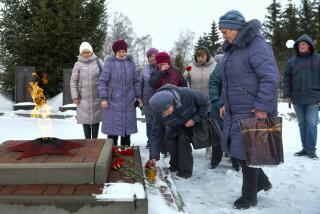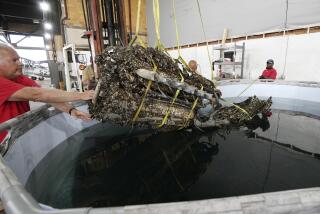Amateur WWII Historians Probe Slovakia Crashes
BRATISLAVA, Slovakia — It’s a sleepy Sunday morning, and the quiet of a field behind the capital’s high-rises is interrupted only by the beeps of a metal detector and the occasional thumps of a hoe.
For Jan Babincak, the day of rest is an opportunity to look for the missing numerical identification of a U.S. warplane that crashed in the field during World War II.
Babincak, 57, and fellow amateur historians have spent hundreds of hours of their free time researching in archives and traipsing through field and forest to find and identify the rusted remains of dozens of American aircraft downed in Slovakia during the war.
“We try to remember those who were almost purposefully forgotten, to return a face to them,” Babincak said. “It is too late to do this, but it’s better than never.”
Their tireless work has drawn some former American servicemen back to Slovakia in recent years for a glimpse of the mangled remains of their planes -- and a chance to close out a grim chapter in their lives.
John Howison, who bailed out with his crew from a damaged B-24 bomber near the western village of Dobra Voda in December 1944, said Slovaks have shown warm hospitality and generosity on his two trips back, most recently last year.
“We toured by rental car and showed my children the remaining bits of the airplane,” Howison, 78, of Bogata, Texas, said in an e-mail. “We met many enthusiasts of WW2 aerial warfare history ... [who] generously gave me pieces of my personal mechanical computer they had discovered at the crash site.”
Aerial history buffs started their search for crashed U.S. warplanes after the communist government was ousted in what was then Czechoslovakia in 1989, opening the way for such activities.
Under communism, official history books glorified the Soviet army and its liberating efforts but largely ignored what the Allies did for Slovakia, which during the war was a puppet state of Nazi Germany.
Over the past decade, Babincak and his friends have pinpointed crash sites for 50 U.S. bombers and eight fighter planes, mostly scattered around the western part of this central European country of 5.4 million people.
Nearly all of the aircraft have been identified. An unknown number of airmen died, but most of those whose planes went down survived the crashes, Babincak said. He did not have details.
“At first, my interest was more technical and statistical -- how it happened and how many planes crashed,” Babincak said. “But over time, as one deals with the history and personal tragedies of these pilots, one’s interest changes.”
Nearly six decades after the war ended, the search for plane parts and crash sites is difficult because of urban development, and because many people who witnessed crashes are no longer alive.
“Too bad we started so late,” Babincak said. “Many of the witnesses and their testimonies are lost.”
The tracking process starts on the ground: buying beers for locals, getting their recollections of crashes on paper, and combing police or church records for more detailed information.
Once the hunters have an idea of a crash site, they sweep the area with metal detectors and begin digging.
Their goal is to find a piece of the aircraft imprinted with its identification number, which can be cross-checked with U.S. Army Air Forces archives to reveal the details of the men who were aboard the plane.
It’s not easy. Babincak has been searching the field on the outskirts of Bratislava on and off for 10 years, looking for a piece of burned metal bearing the identification number of the plane he had determined crashed here.
Because the remnants of the aircraft aren’t going anywhere, Babincak has been focusing on a more urgent task: recording the personal accounts of those who know something about the crash. The technical issues, he said, “can be studied later on.”
Once a crashed plane has been identified, the volunteers erect a simple memorial at the site -- a plaque usually affixed to a propeller fragment or other crash debris.
“It’s a small repayment to those who risked their lives,” Babincak said. “Without their sacrifices, our peaceful life today would not be possible.”
Another former U.S. airman, John Zebrowski, 80, of Liverpool, N.Y., who bailed out with Howison near Dobra Voda, said he “gained a great respect for the people of Slovakia as they risked their lives to prevent me from being captured by the Germans.”
In an e-mail message, he said he welcomed Babincak’s efforts.
“Others can confirm how much he has done to preserve a chapter in his country’s history,” Zebrowski said. “But my daughter, sons and I know as well as anyone what a great ambassador of goodwill he is for us.”
More to Read
Sign up for Essential California
The most important California stories and recommendations in your inbox every morning.
You may occasionally receive promotional content from the Los Angeles Times.









